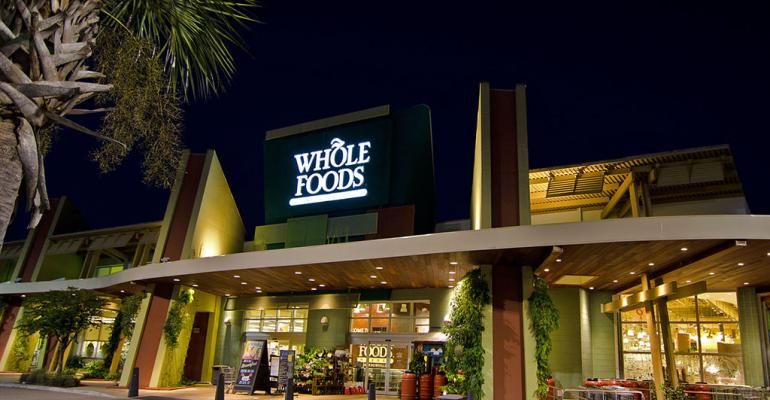Competition in the cutthroat grocery business is heating up even more. Whole Foods Market Inc. announced a new value-oriented concept targeted toward Millennial shoppers, touting it as “unlike anything that currently exists in the marketplace.”
Details on the new store concept, including its name, are sparse, but during Whole Foods’ second quarter conference call, John Mackey, co-founder and co-chief executive officer of Whole Foods Market, said the chain has already put together a team, is in the midst of negotiating several leases and plans to open the first stores next year.
“We want to underscore we see this as an ‘and’ to our Whole Foods Market brand, and not an ‘or,'” Mackey said. “We believe the growth potential for this new and complementary brand to be as great as it is for our highly successful Whole Foods Market brand.”
Demand for fresh, healthy food
Mackey told conference call participants that the new format will feature a modern, streamlined design, innovative technology and a curated selection. “Over the past several years, we have explored the idea of new formats several times but never felt the time was right, particularly given our accelerated growth plans,” he noted. “That issue is now behind us, as we have successfully increased our new store openings for six years.”
He added: “I think we think by creating a second growth vehicle for our company, we can broaden the accessibility of fresh healthy foods, and we will continue to be leaders in that sense.”
In addition to the new store concept, the chain is on track to report its sixth consecutive year of record new store openings. On average, Whole Foods has opened 36 stores per quarter. Currently, the chain operates 420 stores and has another 114 in development. Long-term plans call for 1,200 stores nationwide.
One of those stores is located at the 186-acre mixed-use CityLine project in suburban Dallas. Whole Foods will anchor the initial 81,000-sq.-ft. phase of Regency Centers Corp.’s CityLine Market. The 40,000-sq.-ft. store is scheduled to open early next year.
“The shift in focus to the fresh, convenient and organic has been a large movement,” says Scott Prigge, senior vice president of national property operations for Regency Centers. “We try to find the best grocer to fit the lifestyles and needs of the different communities. There isn’t a cookie-cutter or one-size-fits-all model for finding that perfect fit, but as customer preferences and tastes change, then so will the grocers and what they are offering.”
During the second quarter, Whole Foods’ sales increased 10 percent to $3.6 billion, driven by comps of 3.6 percent and square footage growth of 11 percent. The same-store comps were down from 4.5 percent during the first quarter.
Mackey attributed the slowdown to the larger macro environment. “The exploding demand for natural and organic products has resulted in increased competition from many different channels,” he explained during the earnings conference call.
Specialty & value grocers expand
Beyond Whole Foods, a number of specialty grocers continue to expand, including Sprouts, Trader Joes and The Fresh Market. In addition, value-oriented chains like Aldi and WinCo Foods are entering new markets.
“Over the past several years, the grocery business has been a proxy for the retail sector overall,” notes Terry Montesi, CEO of Trademark Property Co., a Fort Worth, Texas-based developer that focuses on mixed-use and urban projects. “Specialty retailers and value-oriented retailers continue to expand, while the retailers in the middle get squeezed. In the grocery business, that means traditional grocers.”
Next month, Trademark’s WestBend development in Fort Worth will welcome the city’s first Fresh Market. The chain has been expanding in the Dallas-Fort Worth Metroplex, despite the fact that the region is an intensely competitive food market. At WestBend, The Fresh Market will occupy the ground floor of a new 81,150-sq.-ft. building with 57,000 sq. ft. of class-A office space above.
“We love having a specialty grocer as one of the anchors in our centers, whether mixed-use or experiential,” Montesi told NREI. “They bring the right customers to our centers, and it’s a frequent trip. A lot of fashion retailers tell us that they love to be in a center with a specialty grocer because they share customers.”
Walter Robb, co-CEO of Whole Foods, said the chain’s new concept will target customers that aren’t attracted to Whole Foods original concept. “We see a whole generation of young people coming up who are quite interested in national organic foods,” he pointed out. “They’re idealistic. They’re value oriented. They’re mission driven. These all play to Whole Foods Market strengths.”
During Whole Foods’ conference call, Mackey acknowledged that it’s possible the new concept could draw some customers away from the chain’s core concept. However, he maintained the new stores are the right step for the brand.
“You have to be willing to do what it takes to serve your customers better,” Mackey noted, “and you can’t not do that because it might possibly take sales from your existing flagship brand. You’ve got to be willing to serve your customers where you find them. That will be cause the Whole Foods Market flagship brand to evolve as we roll out our as our next brand.”

